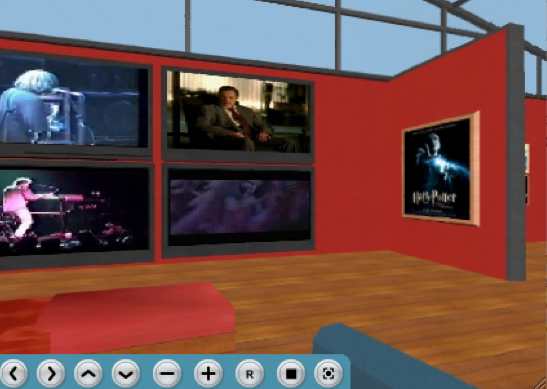
Move over Second Life. The 3D Web is starting to make inroads into the plain old browser. By “plain,” I mean only Internet Explorer on Windows machines—which for now is what you need to experience Vivaty Scenes. But at least it’s a start. (Firefox support on PCs is coming in a few weeks, but Mac support is being pushed off further).
Vivaty Scenes is launching today in public beta on AIM and in Facebook. These are realistic rooms that act as virtual personal environments—a 3D version of your personal page. You can set the theme, decorate with furniture and other virtual goods, and chat with the avatars of friends who enter your room (they need to install the app as well). The best part is that you can bring in photos from Flickr and Facebook, or videos from YouTube and display them on screens in your room. You can play MP3 songs as well.
The graphics are a cut above what you’d find in pre-teen virtual-world social networks like Club Penguin, Habbo Hotel, or Cyworld. They are more along the lines of Second Life or a Sims videogame. Vivaty is backed by Kleiner Perkins and Mohr Davidow. It raised $9.2 million in August, 2007, and a $200,000 seed round before that. Says CEO Keith McCurdy:
We are enabling full-featured 3D experiences inside a Web browser, instead of a separate application like Second Life. Every virtual environment—we call them scenes—is a URL.
That could be a game-changer if Vivaty’s platform takes off. It is deep linking into the 3D Web. Since they have regular URLs, each 3D scene can be linked to from the regular Web. Even objects within each room can each have their own URL. That is what is exciting about Vivty Scenes. It is extending the Web to 3D environments. Vivaty Scenes work only with AIM and Facebook for now, but they can work with other services such as iGoogle, My Yahoo, or as standalone Web pages.
Here is a demo video that shows what you can do in a Vivaty Scene. Remember, this is all browser-based.
McCurdy used to be the VP of worldwide technology at Electronic Arts, where he started Ultima Online. But he thinks that treating virtual worlds like a big online videogame is a mistake. Making a dig at the parcel approach used by Second Life to distribute and develop virtual land, McCurdy notes:
If you wanted to build the original 2D Web, you wouldn’t build it knowing the exact size of every Webpage. The beauty of the Web is that it is an unknown number of links.
While Vivaty is hosting all the rooms to begin with, its technology is architected to become distributed, like the Web itself. Vivaty Scenes are created using standard Javascript and PHP, and can be hosted on standard Web servers. McCurdy doesn’t want to create another walled garden. He wants to bring the Web into the 3D world.
The way he plans to make money is to become the virtual “cash register” for all the virtual goods he expects will be traded between Vivaty users. He also thinks there are obvious advertising opprotunities, including videos on the in-room screen, posters, and billboards, virtual product placement. It would be similar to videogame advertising, except that it need not be disconnected from ad campaigns on the Web.
The big money, though, could be in branded scenes and Websites. For instance, today Target is launching its own Vivaty-powered Facebook application called the Target and Coke Zero Virtual Dorm Room. It’s a back-to-college thing where students can play around with furnishing and decorating their own rooms. The gallery of virtual items features products that can be found at Target, of course.
This sorts of virtual-world advertising hasn’t worked that well because it was disconnected from the regular Web and people’s social networks. Vivaty hopes to prove that, given the right context, this kind of branding can thrive. We’ll see.

